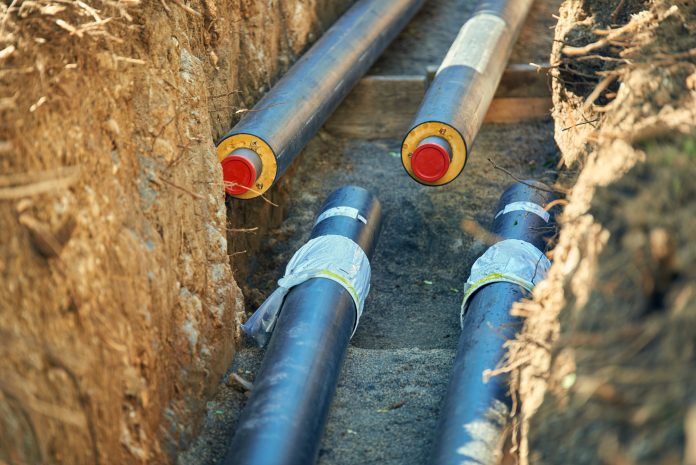Andrew Turton and Lindsay Sugden from Delta-EE state the case for maximising the UK’s opportunity for integrated low carbon heat networks
The transition to “new heat” – which is lower-carbon, smarter, and more customer-focused – is underway. District heating (DH) is a heating scheme which provides heat from a central source to two or more buildings, up to a city-wide system. DH can either remain as “old heat” – ultimately being squeezed out of the UK heating market, or it can play a key role in the transition to “new heat”, alongside electrification and low carbon gases.
DH is the prevalent solution in urban areas across many northern European countries, but despite endless analysis, discussion, and feasibility funding at a local level, it has made little impact on the UK heat markets outside of a few high-profile schemes and large urban redevelopments. Importantly, it has made virtually no inroads into the retrofit market, the main decarbonisation challenge where DH should and needs to excel. These delays and challenges have also led to many questioning the future benefits of DH schemes in light of heat losses, the economics of installing, and reduced CO2 benefits arising from the rapid electricity network decarbonisation and resurgence in gas network innovation and low carbon gases. DH in the UK is in danger of being labelled “old heat” and being forgotten.
Delta-EE believes we are at a tipping point in the energy transition/transition to new heat – and that DH can be a key solution in this. Currently, a potent mix of heating market and wider energy market drivers are creating the conditions within which new heat solutions and services will flourish – or flounder:
- Decarbonisation of heat is increasingly high on the political agenda.
- Digitalisation is changing the way technology interacts with the supply chain, and enabling greater customer engagement.
- Service-based business models and new customer propositions are emerging as providers fight for the customer.
- The increasing need for energy system flexibility is creating new value streams.
If DH in the UK can modernise, adapting to, enabling, and benefitting from these trends, it has a bright future.
What does this mean for DH providers?
DH can be at the centre of the transition, but it needs to move away from fixed ideas around traditional DH infrastructure to providing district-wide heat solutions using innovative systems:
- Reduce dependency on fossil fuels for heat generation and integrate renewables – heat pumps, solar, geothermal, biomass – and waste heat and enabling low carbon heat sources such as heat pumps using secondary heat sources, and waste heat.
- Optimise operation & minimise losses – The UK should be setting leading standards which ensure the latest generation in networks is deployed, using low-temperature distribution to limit heat losses.
- Think decentralised and local – new DH business models may have no central heat production, instead relying on many individual systems in customers’ buildings who both feed into and consume the heat from the heat-grid. And let’s challenge the perception that DH is an urban solution for high-density areas. Innovative small-scale solutions using low-cost technology and installation measures could open up a host of new opportunities in lower-density areas.
- The customer proposition must be at the centre. DH’s propositions now look decidedly old-energy compared with new propositions emerging from nimble start-ups and other players. This means looking at new business models and even providing non-DH solutions for customers where alternatives make more sense.
- Prepare to tap into the growing value streams from energy system flexibility – particularly with the application of heat pumps in district heating, sector coupling between the heating and electricity sector is enabled. Large-scale deployment of DH could provide significant energy storage opportunities for the electricity system, and multi-technology energy centres provide a host of flexibility services.
What’s the outlook?
We are seeing examples across Europe – and in the UK – of the DH industry stepping up to the challenge and becoming more “new heat” than “old heat”.
- The Bunhill DH network in London aims to capture waste heat from the London Underground to provide heat to > 1,300 buildings. Many other schemes are similarly looking at capturing low-grade heat sources using heat pumps.
- In the Norwegian city of Drammen, a large-scale heat pump from UK company Star Refrigeration is providing zero-carbon heat to the city taking low-grade heat from the Fjord.
- In Denmark, the DH industry is now driving the implementation of Heat-as-a-Service propositions as a way to access customers otherwise out of their reach – installing individual heat pumps in buildings outside DH areas and selling the heat on a contract similar to a district heat contract.
- Energy supplier E.On has pioneered the Ectogrid concept – a low temperature, digital, flexible and decentralised heat network – with projects in Sweden, the UK and Germany.
- Energy supplier Vattenfall is working with customer engagement platform provider Eliq to trial new technology for customer engagement and optimisation of DH in homes.
- The UK has several innovative technology developers exploring the digitalisation and optimisation of DH networks, improving the customer experience while making networks more efficient and economical to run.
The UK could be a leader in the next generation of DH, but it requires an integrated energy systems approach where policy drives new solutions and value for customers. The UK must learn from the established markets in Europe, but use this window of opportunity to roll out a transformational approach to DH.











